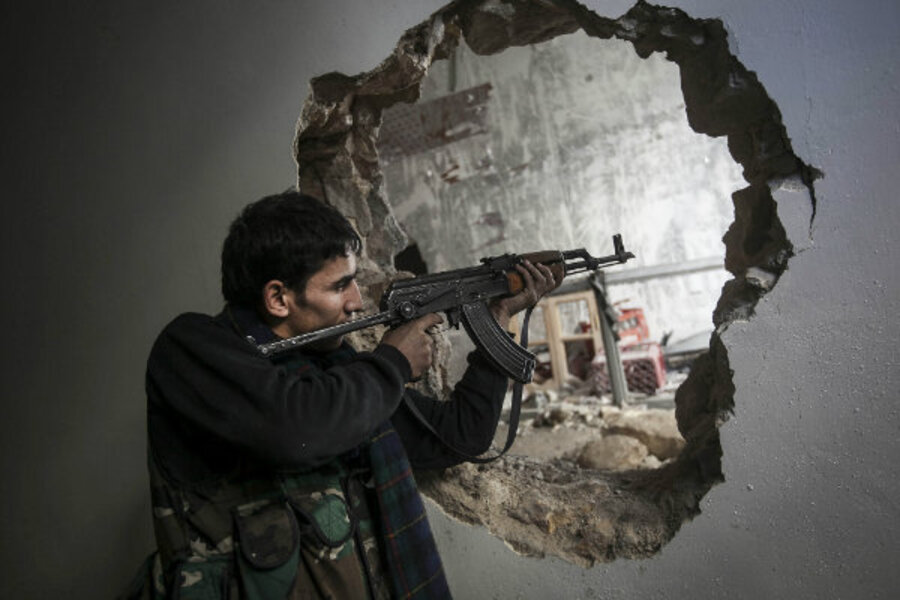Threat of chemical warfare in Syria means it's time for US, NATO no-fly zone
Loading...
| Kabul, Afghanistan
President Obama’s warning to Syria’s President Bashar al-Assad not to use chemical weapons in the country’s ongoing civil war is just one more signal that in this ever-escalating crisis, it's time for the international community to intervene.
Whatever course of action may be next for the US and NATO, arming divided rebel groups should not be considered. While the opposition Free Syrian Army (FSA) and Syrian National Council (SNC) work out their internal politics, the US and NATO should create and enforce a no-fly zone aimed to provide support to civilians on the ground.
The threat of chemical weapons worsens the situation and strengthens the case for a no-fly zone. Mr. Assad’s regime has demonstrated its willingness to engage civilians on a routine basis; therefore, it is paramount that Western powers adopt an appropriate humanitarian response. A no-fly zone will provide protection to Syrian civilians from the regime’s warplanes and artillery barrage and help remove the threat of chemical weapons being used against the Syrian populace in an aerial attack.
Providing weapons to a disorganized FSA and marginalized SNC would be disastrous. Although weapon caches may be scarce, which has led many FSA units to manufacture homespun grenades and rockets, divisions among rebel fighters are simply too great to arm them. History shows that doing so could prove catastrophic in a post-Assad Syria.
Supporters of the FSA and SNC are asking the United States and NATO allies to provide weapons to topple the Assad regime. They state that surface-to-air missiles are needed to shoot down MiG and L-39 warplanes and artillery is needed to push back advancing troop and tank columns.
What isn’t mentioned is the broad gaps in communication between the FSA on the ground and the SNC who have spent years in exile, and who, only a month ago, were deemed a failure by US Secretary of State Hillary Rodham Clinton. There are additional divisions within the various rebel groups. As my recent trip to Northern Syria and the city of Aleppo highlighted, the current conflict between the FSA and Syrian Kurds, supported by Kurdish separatists in Iraq (the PKK), is escalating. Manned and heavily armed check points have been established dividing FSA and Kurdish controlled neighborhoods inside Aleppo.
Additional divisions exist within the rebels. Islamic fundamentalists have taken to the fight, most notably Jabhat al-Nusra, whose use of suicide tactics and links to Al Qaeda in Iraq have been documented by US intelligence officials. Even within the FSA, divisions have arisen. A recent conflict broke out between two FSA groups responsible for controlling the Azaz border crossing with Turkey in Northern Syria. Each group was interested in maintaining a stake in the royalties received from controlling the border; a severe conflict was only narrowly avoided but required FSA units stationed at the front line to travel to the border.
Victory for Assad will mean devastation for dissidents, activists, and the FSA. Not only does a no-fly zone provide added security for civilians, it evens the field of battle between the FSA and the regime. FSA commanders and fighters state their biggest hindrances to success are the Assad regime’s MiG jets and artillery for which the FSA has no defense. A no-fly zone will help to remove these threats while at the same time not provide weapons that could fall into the hands of jihadists and fundamentalists who are also fighting the Assad regime.
The Obama administration set a precedent in the region by working with NATO allies to create a no-fly zone in Libya in 2011. A joint NATO operation in Syria targeting warplanes and artillery will drastically reduce the number of civilian casualties on the ground. So far, an estimated 40,000 Syrians have been killed in the struggle.
Some worry Assad’s ally Iran would retaliate with military force. It is almost certain that Iranian weapons will continue to find their way into Syria – and in greater volume – should NATO or the US unilaterally decide to arm the rebels. However, it is unlikely that Iran will attempt to militarily oppose a no-fly zone by the US or NATO. A joint NATO-US initiative – as opposed to US unilateral action – lessens the threat of Iranian retaliation. Iran will be less inclined to engage NATO allies who, should Iran halt its nuclear enrichment program, would be key economic partners for Iran’s struggling economy.
Historically, arming rebel groups can become a parlous endeavor. In the 1980s, the US government unilaterally supplied weapons to the mujahedin fighting Soviet troops in Afghanistan. What followed a mujahedin victory was a civil war in which US-provided weapons were used to decimate the civilian population throughout the country. At the time it armed the group, the US failed to understand the ethnic and religious divisions within the mujahedin ranks. The civil war that ensued only furthered to weaken the country and paved the way for the creation of the Taliban government.
It’s difficult to predict the direction a post-Assad Syria will go. It is not likely to become either a fully failed state or stable democracy. However, it is almost certain that the US and NATO allies will be drawn into a further conflict there, now or in the future, should they supply arms to groups that are only fractionally aligned.
Daniel Seckman is director of Enrollment Management at the American University of Afghanistan. He has been in Afghanistan for the last seven years and is currently writing a book on the languages of the Nuristan region there.





